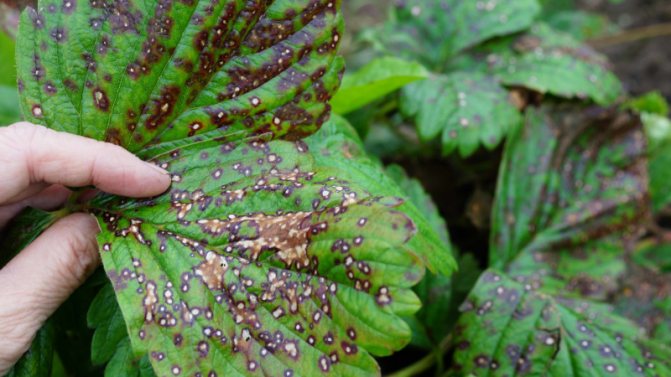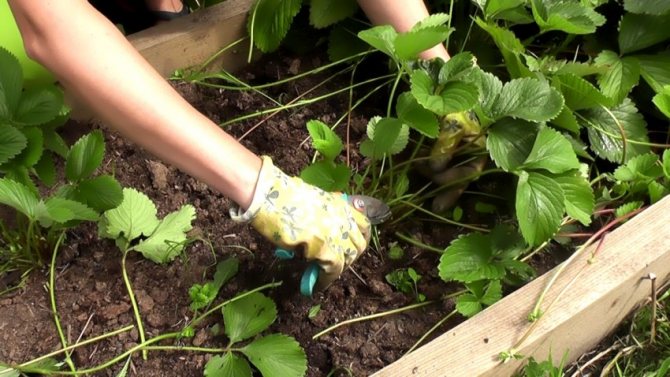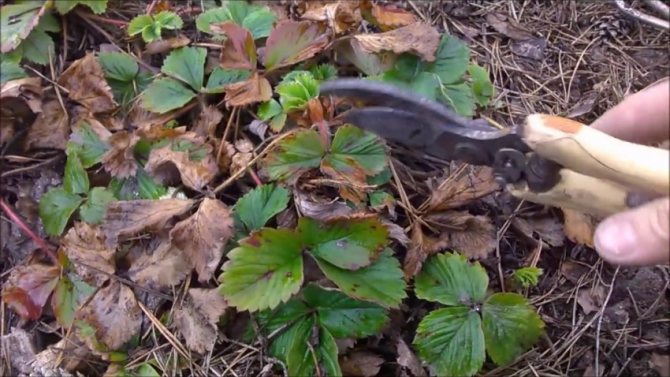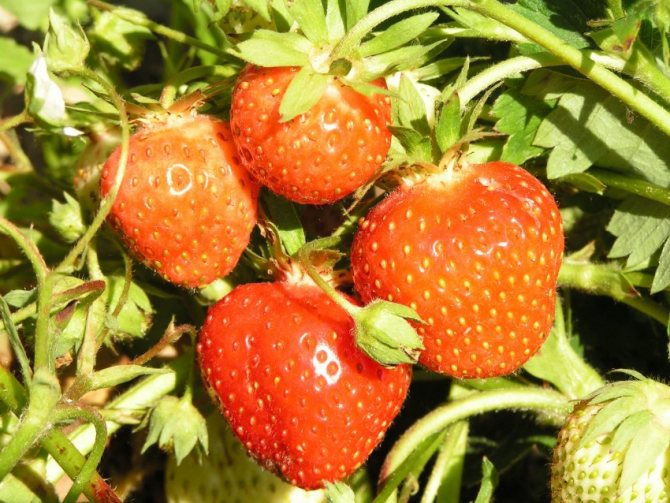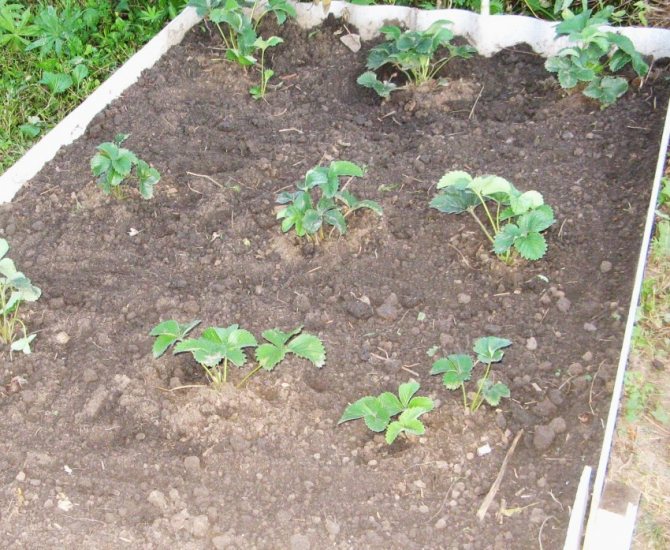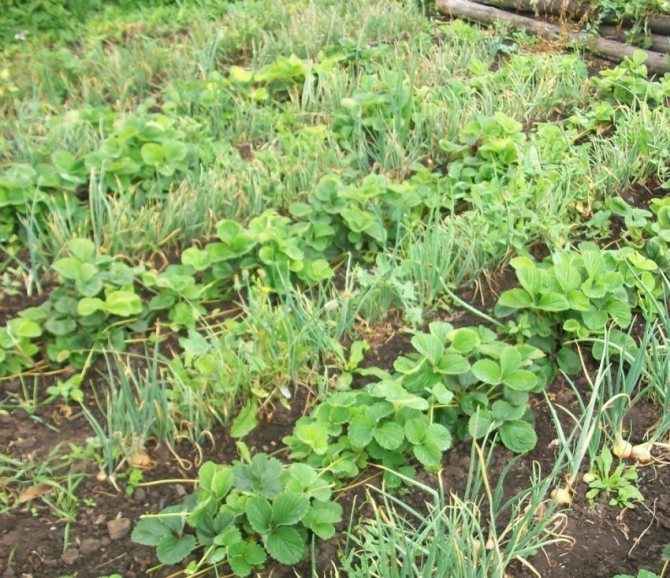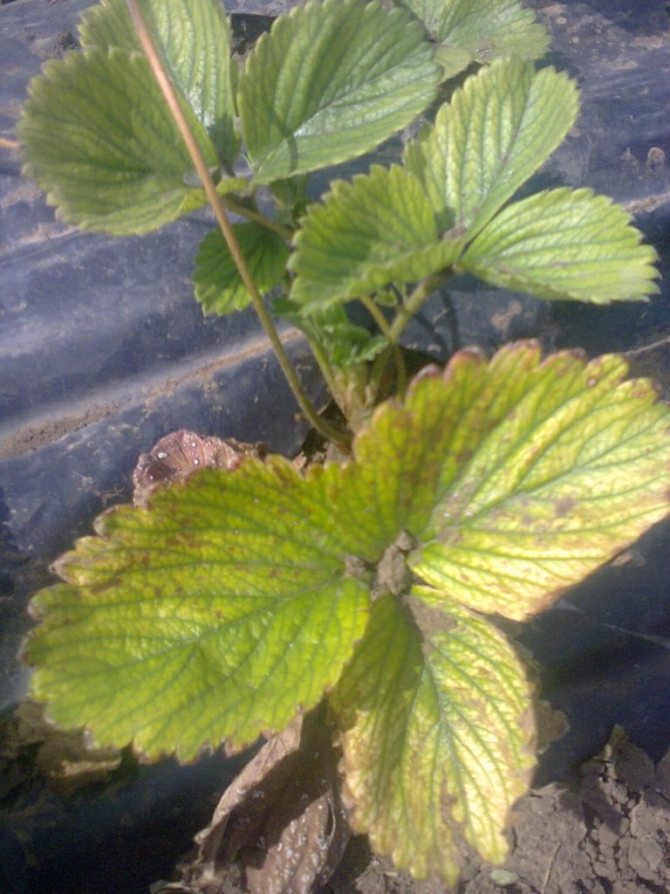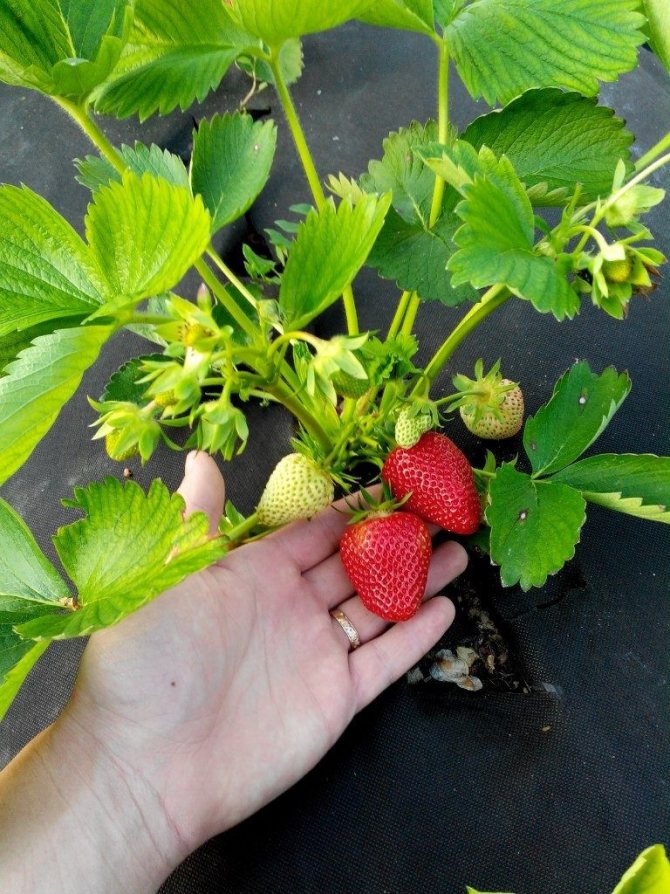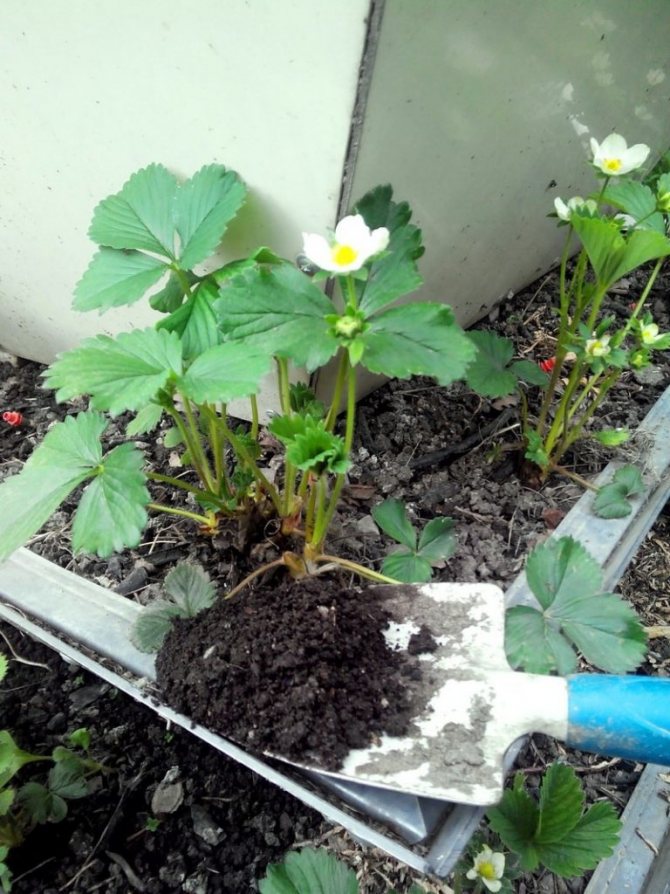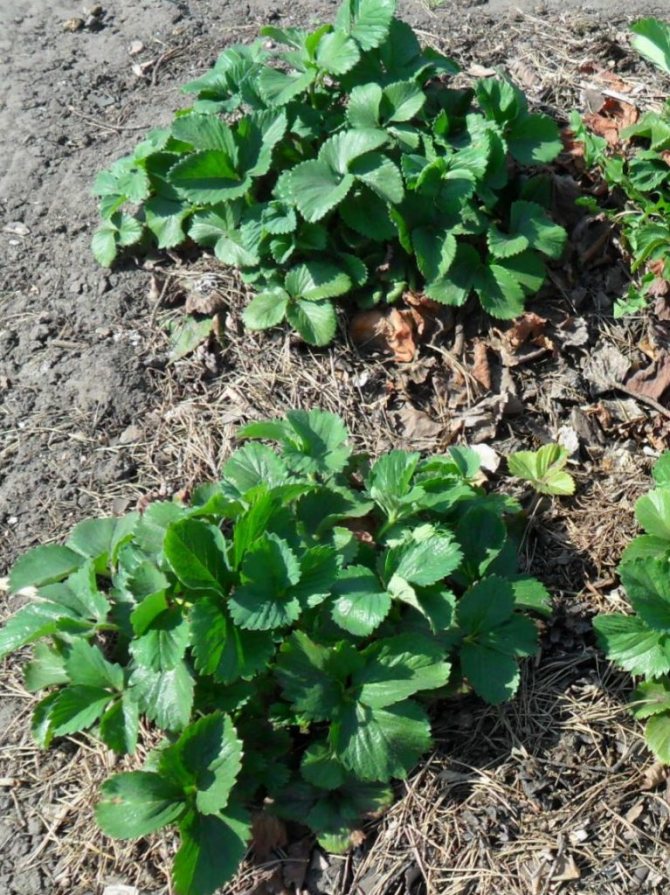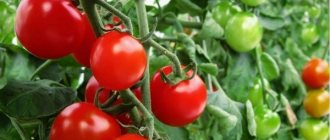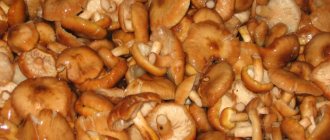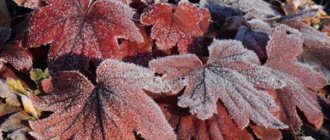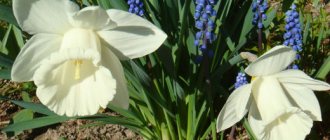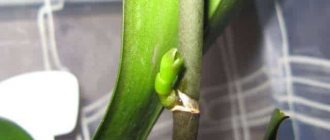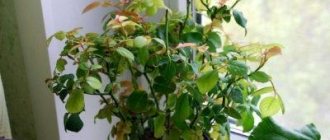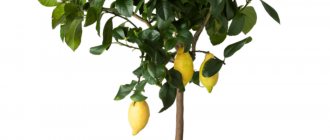
Strawberries are one of the most beloved berries in our country. It is good when the bushes stand in an even "line" on the garden bed, are luxuriantly leafy, give a lot of juicy fragrant berries. But what to do if suddenly the leaves on the strawberry began to turn red. When this is a normal phenomenon, and when a sign of a serious illness, how and with what it may be connected, the reasons, as well as the methods of struggle and prevention, should be known to any summer resident.
Causes of reddening of leaves in strawberries
It is difficult to make a diagnosis in absentia, however, having described the reasons, you can try to push the gardener to those signs, the appearance of which is especially characteristic.
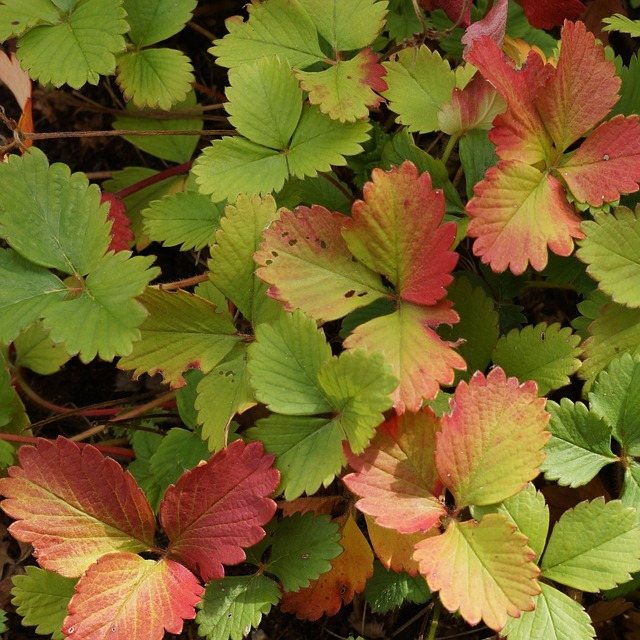

Only in the autumn period reddening of strawberry leaves can be a natural process, while the leaves evenly change their color. But if the redness begins with any spots - this is already a sign of the disease !!!
Reddening of the leaves can be with:
- lesions by microscopic fungi;
- mineral deficiency.
Whatever the reason, the symptom of "reddening of the leaf plate" cannot be the only one. As a rule, any change entails a whole chain, therefore, for a complete diagnosis, it is necessary to conduct a thorough examination of not only the leaves (young and old) but also the berries, buds, peduncles, root system, and also to assess the growth rate.
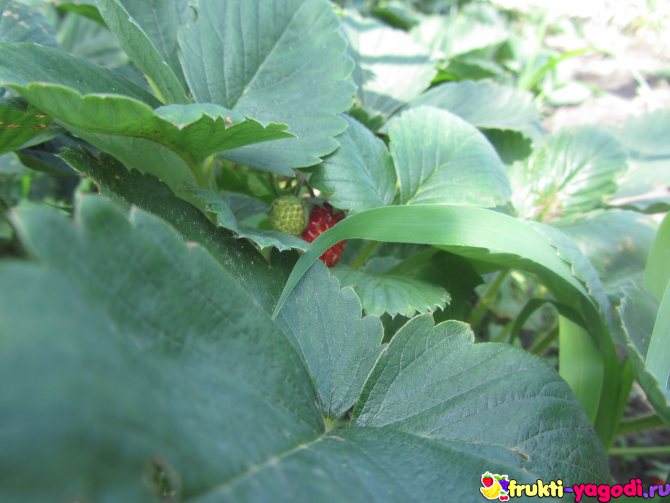

This is what healthy foliage looks like on strawberries.
If there is also a strawberry bed in the neighborhood, it will not be superfluous to compare the state of the foliage, and other signs, on it.
Microscopic mushrooms
There are many microscopic fungi, which, under appropriate natural and climatic conditions, acquire pathogenic forms and cause diseases.
Brown spot
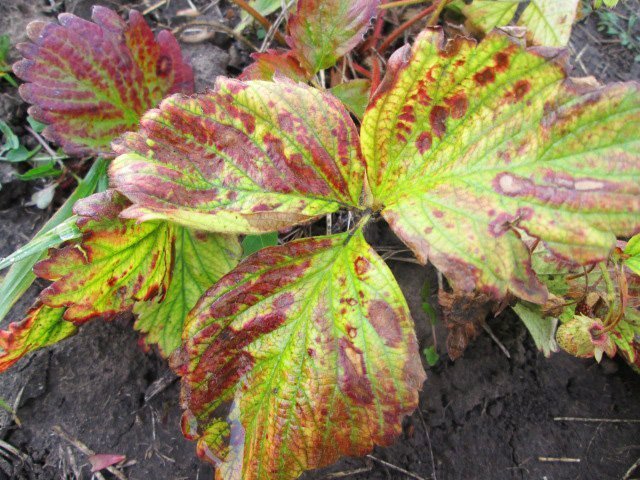

Brown spot can affect the leaves, petioles and whiskers of strawberries.
Initially settling on the leaves, the fungus forms reddish-brown spots with a purple or burgundy frame. Over time, the spots merge, and the strawberry plantation acquires an increasingly reddish-brown "tan".
The fungus affects not only foliage, but also leaf stalks, whiskers. Looking closely at the affected leaves, you can see dark, black dots on them.


Another affected strawberry leaf.
The fungus overwinters well on affected plants.
Brown spot
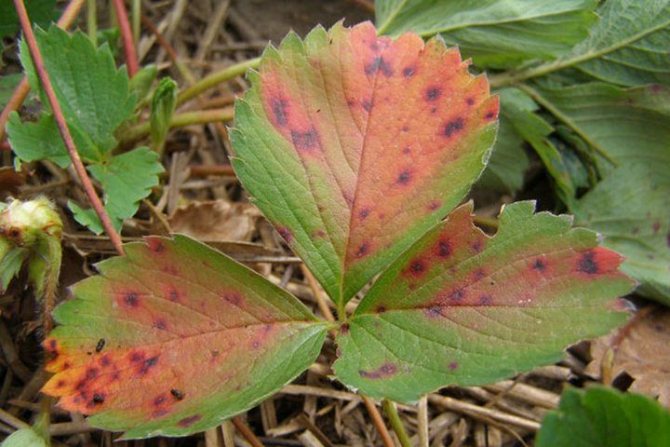

Brown spotting begins with small dots and specks that coalesce as the disease progresses until the entire leaf turns brownish brown.
The fungus that causes this disease rarely affects the petioles and whiskers., their fabric is "harsh", but the leaf plate suffers more.
In this case, the spots are first red-purple, then they turn brown. You can personally observe how the red plantation turns into a brown one.
White spot
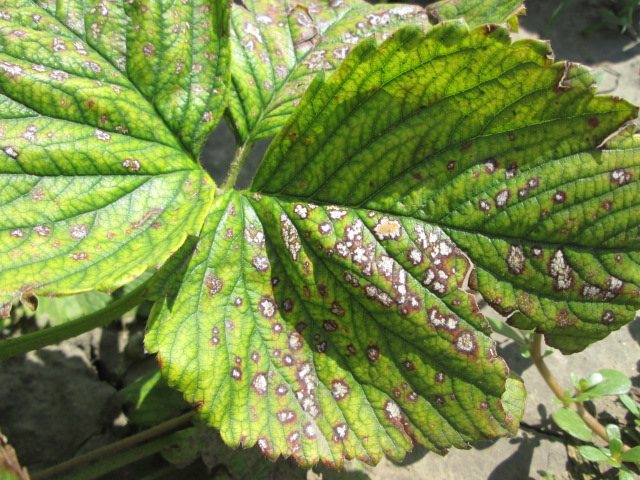

The first symptoms of the disease appear in the spring, with the peak usually occurring at the beginning of the harvest.
It would seem, what is the connection between red foliage and white spot? However, with this disease, the mushroom behaves in such a way that red-brown spots appear on the foliage, framed by a dark red rim... Merging, they make the leaf purple. Further, the spots turn white, and the leaves, after reddening, become, as it were, whitish.
Verticillary wilting


Withering starts from the inner leaves.
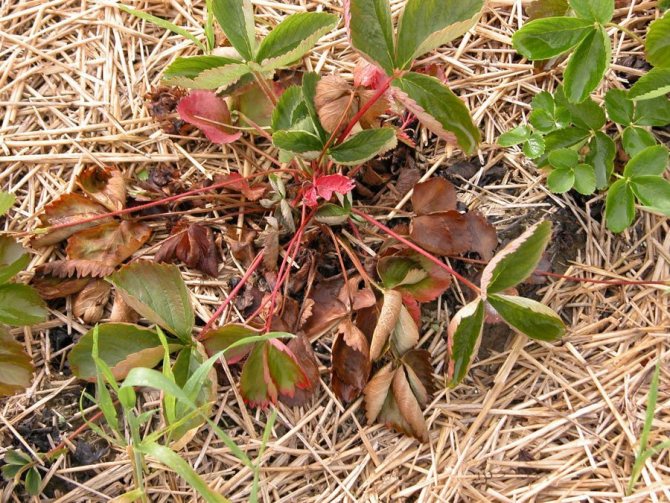

Symptoms appear in hot, dry weather.
The work of this mushroom is especially noticeable, it becomes during the period of budding and fruiting. Old leaves fall on the soil, as if covering it, turn red and wither. Young leaves become pale, lose their gloss, shrink.
The growth of the bushes stops, and the bushes gradually begin to die... If such a bush is removed from the ground, then you can find that the root system is quite severely affected.
Foliage renewal
The appearance of red leaves at the end of the season should not be a cause for concern. At the end of dying off, they begin to turn red from the sides, remaining green. Before the beginning of winter, they completely turn red and die off.
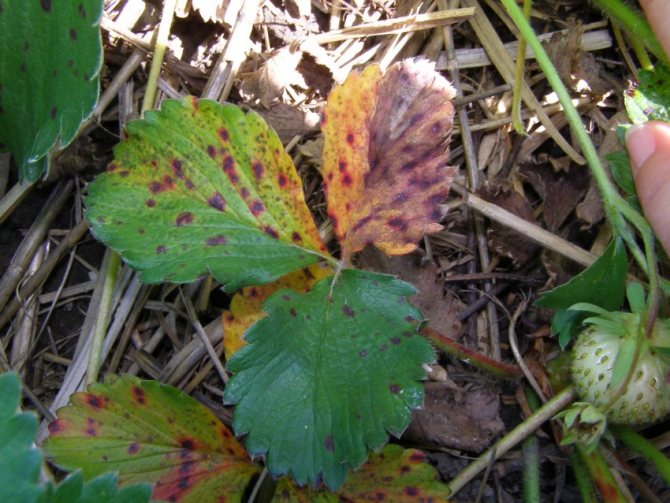

Of particular concern should be leaf reddening in mid-summer.


Control methods


When choosing strawberry seedlings, give preference to local varieties grown in proven nurseries.
When planting a strawberry plantation, you must give preference to healthy material and a trusted seller. As a rule, garden centers and breeding nurseries are jealous of the infectious background, and will not sacrifice their reputation.
- It will not be superfluous to carefully consider the foliage and roots when purchasing, and refuse the purchase at the slightest suspicion.
- Wet weather and wind contribute to the spread of fungi.
- The affected foliage must be collected and burned. The mustache must be removed, and in the year of the rampant fungal infection, planting material should not be selected.
- As soon as the crop is harvested, it is necessary to treat the plantation with Bordeaux liquid or 3% copper sulfate solution. After 30 days, the treatment should be repeated.
- If last year the strawberry bed was under the influence of a fungal infection, then in early spring, the treatment is carried out with copper-containing preparations until the period of the protrusion of the peduncles.
The appearance of brown spots - the manifestation of brown spot
Sometimes dark purple spots appear on the leaves. They are of irregular angular shape and are limited by leaf veins. Dying off, the leaf changes color to brown. This is the first sign of brown spotting. The disease manifests itself in the last 2-3 weeks of summer. To stop the disease, it is better to take preventive measures in advance: at the beginning of the season, even before leaves begin to appear on it, spray the strawberries with Topaz or treat them with a special compound. To prepare it, you need to mix 200 g of slaked lime and 150 g of copper sulfate. The mixture is diluted in 5 liters of water.
Very good results are obtained by treating the area with Bordeaux liquid or potassium permanganate (solution). But, destroying the spores of fungi, these funds are able to destroy all the microflora useful in the soil, therefore it is very often not recommended to use them. Although the treatment of brown spot is not very difficult, it is still easier to prevent it from occurring. For this you need:
- Planting planting material purchased from trusted sellers.
- Transplant strawberries to a new location every 3-4 years.
- Constantly cut off diseased leaves and whiskers, and remove them from the site. It is best to destroy the contaminated material.
Lack of nutrients
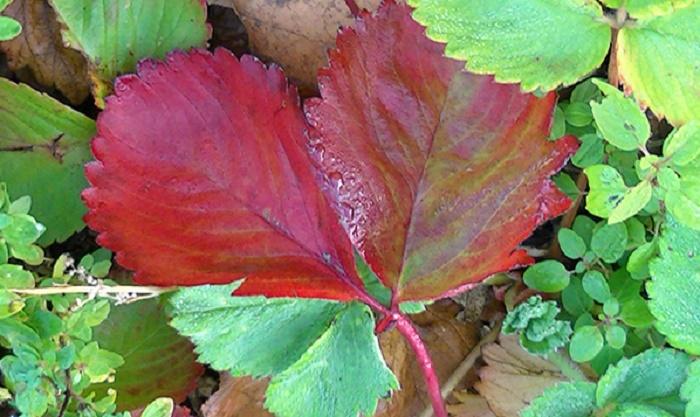

In some cases, reddening of strawberry leaves indicates a lack of certain nutrients in the soil.
Sometimes the redness of the leaves is a call for help. The plant signals that there are not enough minerals, or they are there, but are in a form that is inaccessible for assimilation.
Phosphorus
If the signs are analyzed and the fungal infection is not detected, then the strawberry bed becomes crimson with a lack of phosphorus.
The element phosphorus is one of the most essential.
It participates in the synthesis of proteins, enzymes and vitamins, and sugar phosphates are formed in the process of photosynthesis, as well as chlorophyll, which is responsible for the green color. Phosphorus is an active participant in respiration and fermentation, energy, nitrogen and carbohydrate metabolism... The energy of the sun is accumulated in the leaf plates in phosphate bonds and is used by all the cells of the plant organism. The absorption of nutrients from the soil, their synthesis and transport to cells also depends on the presence of this element.


To saturate the soil with this element, fertilizers of the phosphorus group are used.
Nitrogen
The process of organic matter production is most intense in young cells of the bush and is closely related to nitrogen.
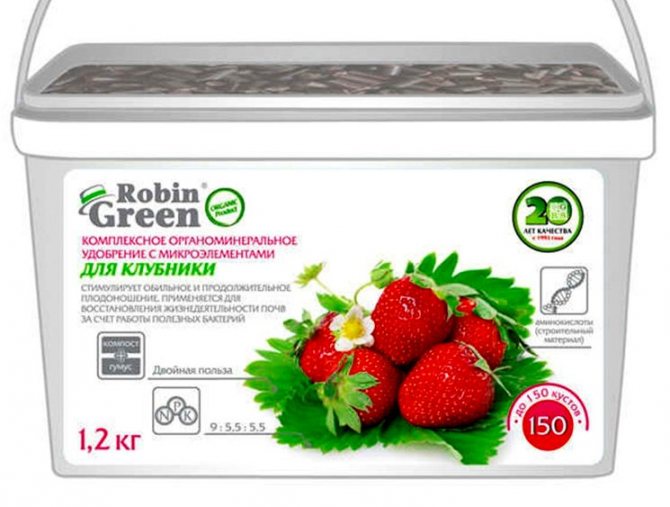

Special complex fertilizers contain all the necessary components in certain proportions.
If these elements are insufficient, phosphorus can move from older foliage to young. In this case, the leaf loses its green color and becomes red-purple. Looking closely at the older leaves, you can see that they are the first to turn scarlet.... Initially, redness begins at the edges of large old leaves and gradually spreads to the entire surface.
With a lack of phosphorus, not only the foliage turns red, but the entire bush slows down growth, productivity decreases, and the taste of the fruit deteriorates.
Reasons for indigestibility
It is customary to consider any pathology in a complex manner.
- On the one hand, minerals may not be absorbed because the root system is weak. Underdeveloped, it may be due to abnormal weather conditions. Intense heat, lack of watering and rain, do not allow young roots to develop. If you dig up a bush and examine the root, it becomes clear that it penetrates very shallowly into the soil, and the scorching sun constantly dries up the soil in its surroundings. Constant moisture, excessive rainfall or low-lying plantings lead to the fact that young roots rot out, and the old ones are no longer able to absorb nutrients.
- The other side is that phosphorus as an element cannot be used by a plant cell without nitrogenous compounds. If from year to year only furnace ash is applied to a strawberry plantation, without nitrogenous mineral and organic fertilizers, oversaturation occurs, but such phosphorus is not available.
The appearance of small holes on strawberry leaves is a sign of a pest
A similar problem is evidence of the appearance of a weevil beetle in the beds, it is for this pest that such damage is characteristic. Most often this happens if there are beds of radishes and carrots next to the berry beds. Insects can very easily fly from one crop to another. Strawberries need to be processed to protect against the weevil beetle even before they bloom.
For processing, use "Tsipershans" - this tool will eliminate weevils and other types of pests. But this drug is a chemical agent, therefore it is used only in cases where a lot of beetles have grown, if so far not so many pests of this species have been found, biological preparations can be used for processing.
| Name | Features of the | Properties |
| Fitoverm | The drug is of intestinal action. The effectiveness of the product was proven during testing at the All-Russian Research Institute and amounted to 98-100%. | The drug is effective in any weather, is not phytotoxic, does not pollute the environment. |
| "Akarin" | Safe for humans. | It is a fast-acting drug - after 4-5 hours, insect pests stop feeding and soon die. |
| Iskra Bio | Natural preparation for the destruction of insect pests on ornamental, berry, fruit and vegetable crops. The basis of the drug is avermectin. It is a natural substance that paralyzes pests. Approved for use in greenhouse conditions and in the open field. | The tool is effective in any weather, it can destroy insects that do not react to other drugs, it destroys both adults and larvae. |
Brown spotting of strawberries may also appear, which also has a rather specific appearance, as it looks in close-up, you can see in this photo
In addition, the weevil can cause the leaves of the strawberry to begin to dry. This is due to the fact that the weevil remains on strawberry leaves for wintering. When the first leaves appear, he feeds on their juice, after which they dry up. The buds on the stalk also dry out. If such a picture has to be observed on the site, then it is too late to process the bushes, since the insect has already flown over to the raspberries. But it will be possible to protect the future harvest in the fall by treating the strawberries with any of the listed drugs.
Tip # 2. If you do not fight the weevil, it is able to destroy not only strawberries, but also completely the harvest of all berry crops both on the site and from neighbors - the insect can fly over fairly long distances.
But the most important thing is prevention. Such a simple trifle as harvesting yellowed, reddened, dried leaves from plants in time will allow the plantings to remain ungrown, so that many problems can be avoided.
What to do?


To maintain the nutritional balance, it is most reasonable to alternate mineral fertilizers with organic fertilizers.
Complex, regular fertilization can save the situation, but, unfortunately, not this season. The processes of phosphorus starvation are irreversible. Time is wasted, you can't count on a good harvest, but there is every chance to restore the balance and save the strawberry garden.
- If fertilizers have never been applied, then in this case we apply phosphorus-potassium fertilizers in the fall. Dissolving 2 tbsp. tablespoons of superphosphate in a bucket of water under the bush, add 200 g each.
- It is necessary to spread the rotted manure along the row spacing - a bucket per running meter.
- In the spring, we carry out two additional fertilizing with nitrogenous fertilizers: the first at the beginning of the growth of foliage, the second during the period of extension of the peduncles.
Application rates of phosphorus group fertilizers.
Feeding strawberries is a very responsible event, not only the yield, but also the taste of the berry depends on how and when it will be carried out.
Prevention
In order to prevent foliage from reddening, it is necessary to plant the plant on fertile land in well-lit and sufficiently ventilated places. Prevent thickening of the bushes by regularly removing old shoots.
Carefully examine the plants, remove the resulting red leaves. Remove damaged and dry bushes. Weed regularly. Dig up and loosen the soil between the rows.


Periodically fertilize and treat against various diseases and pests. It is not difficult, the main thing is to hold these events regularly. With this care, strawberries will give good yields of berries and delight with a wonderful sweet taste.



